Business Decision Making Report: Data Analysis, Tools, and Techniques
VerifiedAdded on 2022/12/26
|11
|3033
|1
Report
AI Summary
This report provides a comprehensive analysis of business decision-making processes, focusing on the application of statistical tools and financial ratios within the context of Fortune Trading, a UK-based business. The report begins by outlining various sources of data collection, distinguishing between primary and secondary sources, and discussing the significance of data sampling techniques. It then delves into descriptive statistics such as mean, median, mode, and standard deviation, explaining their relevance in business analysis. Furthermore, the report explores different tools and techniques used in business decision-making, including cash flow analysis, current ratio, net profit margin, and debt-to-equity ratio, highlighting their utility in assessing a company's financial health and guiding strategic decisions. The report also emphasizes the importance of presenting information through charts and graphs for effective communication and concludes with a summary of key findings and recommendations for improved business practices.
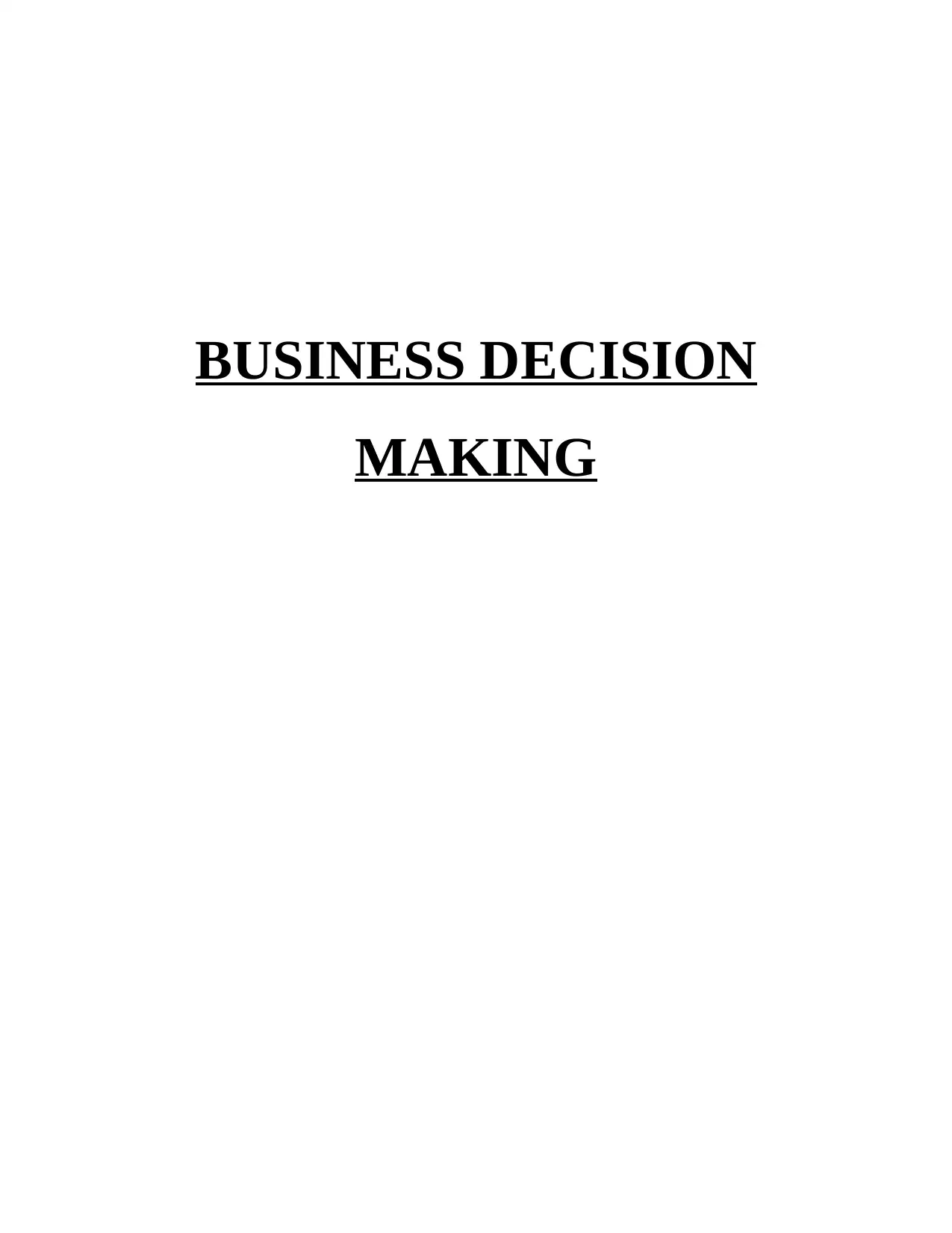
BUSINESS DECISION
MAKING
MAKING
Paraphrase This Document
Need a fresh take? Get an instant paraphrase of this document with our AI Paraphraser
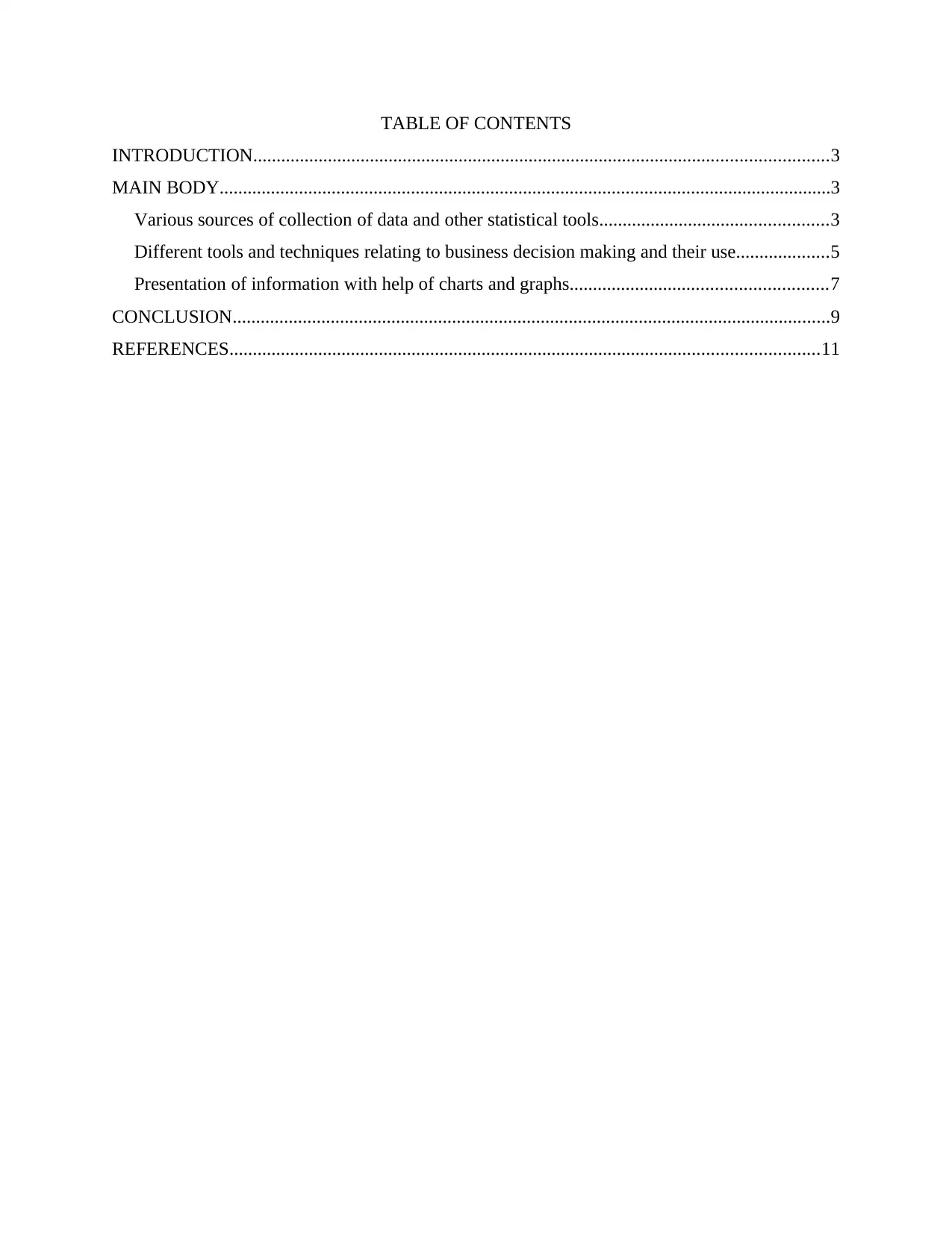
TABLE OF CONTENTS
INTRODUCTION...........................................................................................................................3
MAIN BODY...................................................................................................................................3
Various sources of collection of data and other statistical tools.................................................3
Different tools and techniques relating to business decision making and their use....................5
Presentation of information with help of charts and graphs.......................................................7
CONCLUSION................................................................................................................................9
REFERENCES..............................................................................................................................11
INTRODUCTION...........................................................................................................................3
MAIN BODY...................................................................................................................................3
Various sources of collection of data and other statistical tools.................................................3
Different tools and techniques relating to business decision making and their use....................5
Presentation of information with help of charts and graphs.......................................................7
CONCLUSION................................................................................................................................9
REFERENCES..............................................................................................................................11
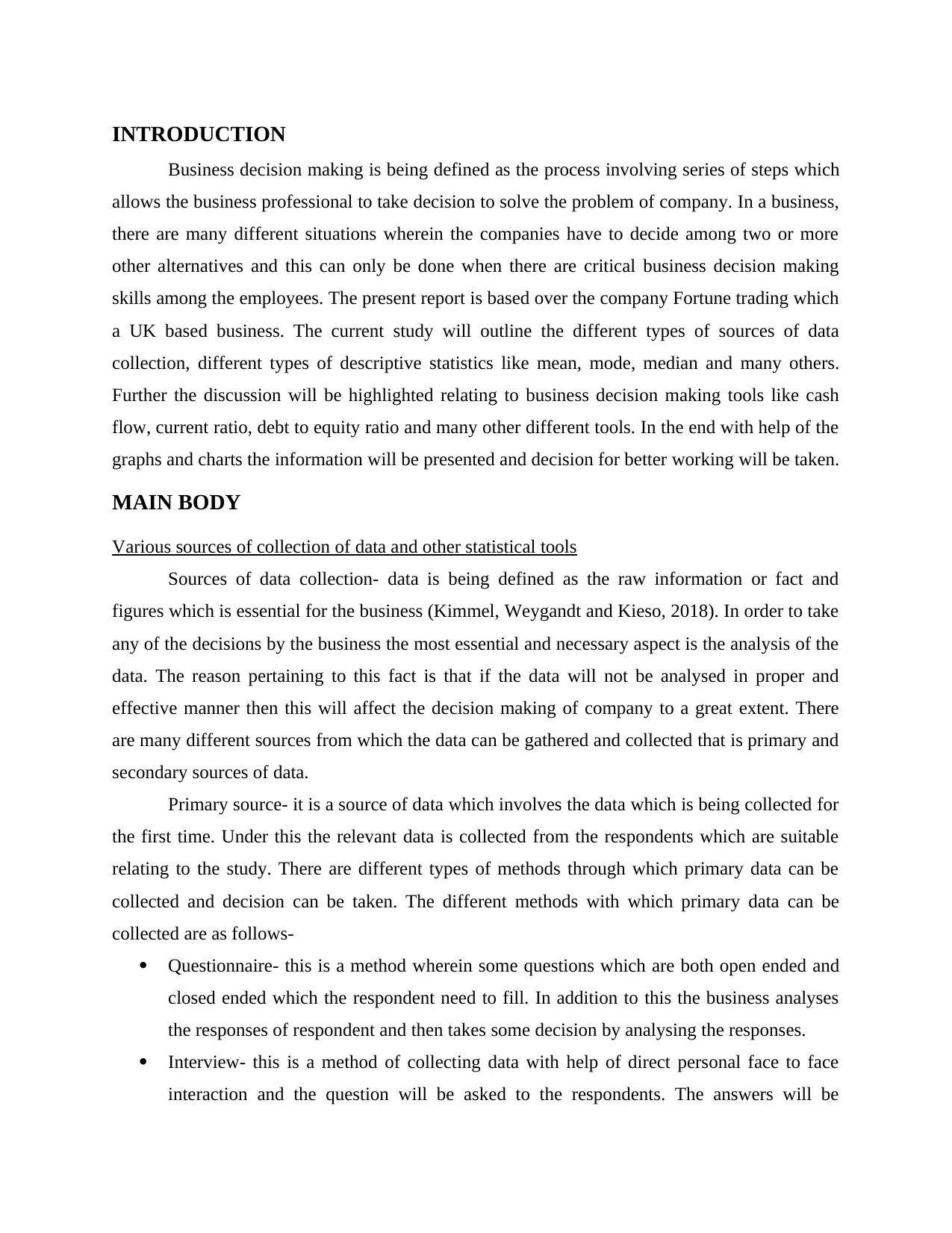
INTRODUCTION
Business decision making is being defined as the process involving series of steps which
allows the business professional to take decision to solve the problem of company. In a business,
there are many different situations wherein the companies have to decide among two or more
other alternatives and this can only be done when there are critical business decision making
skills among the employees. The present report is based over the company Fortune trading which
a UK based business. The current study will outline the different types of sources of data
collection, different types of descriptive statistics like mean, mode, median and many others.
Further the discussion will be highlighted relating to business decision making tools like cash
flow, current ratio, debt to equity ratio and many other different tools. In the end with help of the
graphs and charts the information will be presented and decision for better working will be taken.
MAIN BODY
Various sources of collection of data and other statistical tools
Sources of data collection- data is being defined as the raw information or fact and
figures which is essential for the business (Kimmel, Weygandt and Kieso, 2018). In order to take
any of the decisions by the business the most essential and necessary aspect is the analysis of the
data. The reason pertaining to this fact is that if the data will not be analysed in proper and
effective manner then this will affect the decision making of company to a great extent. There
are many different sources from which the data can be gathered and collected that is primary and
secondary sources of data.
Primary source- it is a source of data which involves the data which is being collected for
the first time. Under this the relevant data is collected from the respondents which are suitable
relating to the study. There are different types of methods through which primary data can be
collected and decision can be taken. The different methods with which primary data can be
collected are as follows-
Questionnaire- this is a method wherein some questions which are both open ended and
closed ended which the respondent need to fill. In addition to this the business analyses
the responses of respondent and then takes some decision by analysing the responses.
Interview- this is a method of collecting data with help of direct personal face to face
interaction and the question will be asked to the respondents. The answers will be
Business decision making is being defined as the process involving series of steps which
allows the business professional to take decision to solve the problem of company. In a business,
there are many different situations wherein the companies have to decide among two or more
other alternatives and this can only be done when there are critical business decision making
skills among the employees. The present report is based over the company Fortune trading which
a UK based business. The current study will outline the different types of sources of data
collection, different types of descriptive statistics like mean, mode, median and many others.
Further the discussion will be highlighted relating to business decision making tools like cash
flow, current ratio, debt to equity ratio and many other different tools. In the end with help of the
graphs and charts the information will be presented and decision for better working will be taken.
MAIN BODY
Various sources of collection of data and other statistical tools
Sources of data collection- data is being defined as the raw information or fact and
figures which is essential for the business (Kimmel, Weygandt and Kieso, 2018). In order to take
any of the decisions by the business the most essential and necessary aspect is the analysis of the
data. The reason pertaining to this fact is that if the data will not be analysed in proper and
effective manner then this will affect the decision making of company to a great extent. There
are many different sources from which the data can be gathered and collected that is primary and
secondary sources of data.
Primary source- it is a source of data which involves the data which is being collected for
the first time. Under this the relevant data is collected from the respondents which are suitable
relating to the study. There are different types of methods through which primary data can be
collected and decision can be taken. The different methods with which primary data can be
collected are as follows-
Questionnaire- this is a method wherein some questions which are both open ended and
closed ended which the respondent need to fill. In addition to this the business analyses
the responses of respondent and then takes some decision by analysing the responses.
Interview- this is a method of collecting data with help of direct personal face to face
interaction and the question will be asked to the respondents. The answers will be
⊘ This is a preview!⊘
Do you want full access?
Subscribe today to unlock all pages.

Trusted by 1+ million students worldwide
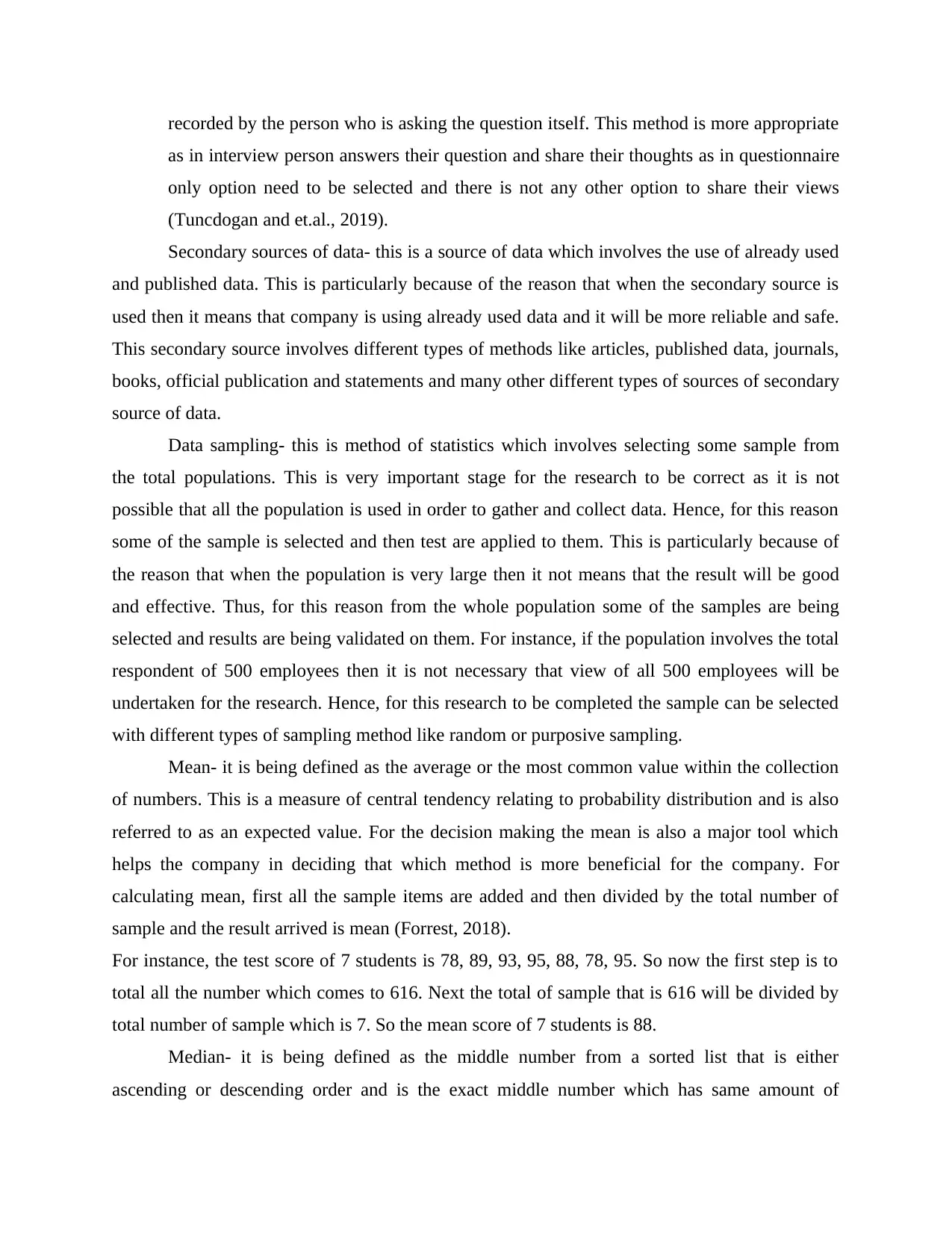
recorded by the person who is asking the question itself. This method is more appropriate
as in interview person answers their question and share their thoughts as in questionnaire
only option need to be selected and there is not any other option to share their views
(Tuncdogan and et.al., 2019).
Secondary sources of data- this is a source of data which involves the use of already used
and published data. This is particularly because of the reason that when the secondary source is
used then it means that company is using already used data and it will be more reliable and safe.
This secondary source involves different types of methods like articles, published data, journals,
books, official publication and statements and many other different types of sources of secondary
source of data.
Data sampling- this is method of statistics which involves selecting some sample from
the total populations. This is very important stage for the research to be correct as it is not
possible that all the population is used in order to gather and collect data. Hence, for this reason
some of the sample is selected and then test are applied to them. This is particularly because of
the reason that when the population is very large then it not means that the result will be good
and effective. Thus, for this reason from the whole population some of the samples are being
selected and results are being validated on them. For instance, if the population involves the total
respondent of 500 employees then it is not necessary that view of all 500 employees will be
undertaken for the research. Hence, for this research to be completed the sample can be selected
with different types of sampling method like random or purposive sampling.
Mean- it is being defined as the average or the most common value within the collection
of numbers. This is a measure of central tendency relating to probability distribution and is also
referred to as an expected value. For the decision making the mean is also a major tool which
helps the company in deciding that which method is more beneficial for the company. For
calculating mean, first all the sample items are added and then divided by the total number of
sample and the result arrived is mean (Forrest, 2018).
For instance, the test score of 7 students is 78, 89, 93, 95, 88, 78, 95. So now the first step is to
total all the number which comes to 616. Next the total of sample that is 616 will be divided by
total number of sample which is 7. So the mean score of 7 students is 88.
Median- it is being defined as the middle number from a sorted list that is either
ascending or descending order and is the exact middle number which has same amount of
as in interview person answers their question and share their thoughts as in questionnaire
only option need to be selected and there is not any other option to share their views
(Tuncdogan and et.al., 2019).
Secondary sources of data- this is a source of data which involves the use of already used
and published data. This is particularly because of the reason that when the secondary source is
used then it means that company is using already used data and it will be more reliable and safe.
This secondary source involves different types of methods like articles, published data, journals,
books, official publication and statements and many other different types of sources of secondary
source of data.
Data sampling- this is method of statistics which involves selecting some sample from
the total populations. This is very important stage for the research to be correct as it is not
possible that all the population is used in order to gather and collect data. Hence, for this reason
some of the sample is selected and then test are applied to them. This is particularly because of
the reason that when the population is very large then it not means that the result will be good
and effective. Thus, for this reason from the whole population some of the samples are being
selected and results are being validated on them. For instance, if the population involves the total
respondent of 500 employees then it is not necessary that view of all 500 employees will be
undertaken for the research. Hence, for this research to be completed the sample can be selected
with different types of sampling method like random or purposive sampling.
Mean- it is being defined as the average or the most common value within the collection
of numbers. This is a measure of central tendency relating to probability distribution and is also
referred to as an expected value. For the decision making the mean is also a major tool which
helps the company in deciding that which method is more beneficial for the company. For
calculating mean, first all the sample items are added and then divided by the total number of
sample and the result arrived is mean (Forrest, 2018).
For instance, the test score of 7 students is 78, 89, 93, 95, 88, 78, 95. So now the first step is to
total all the number which comes to 616. Next the total of sample that is 616 will be divided by
total number of sample which is 7. So the mean score of 7 students is 88.
Median- it is being defined as the middle number from a sorted list that is either
ascending or descending order and is the exact middle number which has same amount of
Paraphrase This Document
Need a fresh take? Get an instant paraphrase of this document with our AI Paraphraser
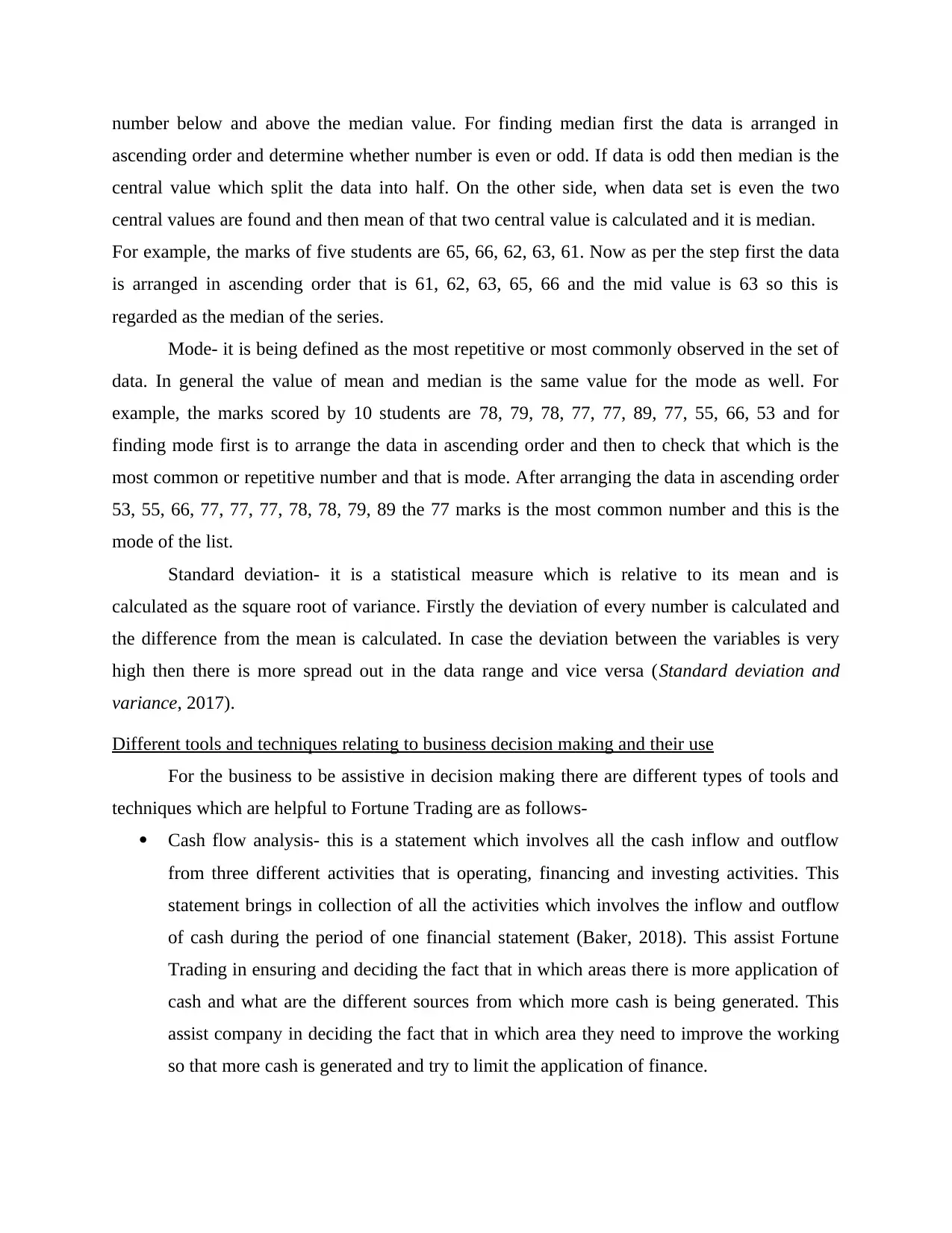
number below and above the median value. For finding median first the data is arranged in
ascending order and determine whether number is even or odd. If data is odd then median is the
central value which split the data into half. On the other side, when data set is even the two
central values are found and then mean of that two central value is calculated and it is median.
For example, the marks of five students are 65, 66, 62, 63, 61. Now as per the step first the data
is arranged in ascending order that is 61, 62, 63, 65, 66 and the mid value is 63 so this is
regarded as the median of the series.
Mode- it is being defined as the most repetitive or most commonly observed in the set of
data. In general the value of mean and median is the same value for the mode as well. For
example, the marks scored by 10 students are 78, 79, 78, 77, 77, 89, 77, 55, 66, 53 and for
finding mode first is to arrange the data in ascending order and then to check that which is the
most common or repetitive number and that is mode. After arranging the data in ascending order
53, 55, 66, 77, 77, 77, 78, 78, 79, 89 the 77 marks is the most common number and this is the
mode of the list.
Standard deviation- it is a statistical measure which is relative to its mean and is
calculated as the square root of variance. Firstly the deviation of every number is calculated and
the difference from the mean is calculated. In case the deviation between the variables is very
high then there is more spread out in the data range and vice versa (Standard deviation and
variance, 2017).
Different tools and techniques relating to business decision making and their use
For the business to be assistive in decision making there are different types of tools and
techniques which are helpful to Fortune Trading are as follows-
Cash flow analysis- this is a statement which involves all the cash inflow and outflow
from three different activities that is operating, financing and investing activities. This
statement brings in collection of all the activities which involves the inflow and outflow
of cash during the period of one financial statement (Baker, 2018). This assist Fortune
Trading in ensuring and deciding the fact that in which areas there is more application of
cash and what are the different sources from which more cash is being generated. This
assist company in deciding the fact that in which area they need to improve the working
so that more cash is generated and try to limit the application of finance.
ascending order and determine whether number is even or odd. If data is odd then median is the
central value which split the data into half. On the other side, when data set is even the two
central values are found and then mean of that two central value is calculated and it is median.
For example, the marks of five students are 65, 66, 62, 63, 61. Now as per the step first the data
is arranged in ascending order that is 61, 62, 63, 65, 66 and the mid value is 63 so this is
regarded as the median of the series.
Mode- it is being defined as the most repetitive or most commonly observed in the set of
data. In general the value of mean and median is the same value for the mode as well. For
example, the marks scored by 10 students are 78, 79, 78, 77, 77, 89, 77, 55, 66, 53 and for
finding mode first is to arrange the data in ascending order and then to check that which is the
most common or repetitive number and that is mode. After arranging the data in ascending order
53, 55, 66, 77, 77, 77, 78, 78, 79, 89 the 77 marks is the most common number and this is the
mode of the list.
Standard deviation- it is a statistical measure which is relative to its mean and is
calculated as the square root of variance. Firstly the deviation of every number is calculated and
the difference from the mean is calculated. In case the deviation between the variables is very
high then there is more spread out in the data range and vice versa (Standard deviation and
variance, 2017).
Different tools and techniques relating to business decision making and their use
For the business to be assistive in decision making there are different types of tools and
techniques which are helpful to Fortune Trading are as follows-
Cash flow analysis- this is a statement which involves all the cash inflow and outflow
from three different activities that is operating, financing and investing activities. This
statement brings in collection of all the activities which involves the inflow and outflow
of cash during the period of one financial statement (Baker, 2018). This assist Fortune
Trading in ensuring and deciding the fact that in which areas there is more application of
cash and what are the different sources from which more cash is being generated. This
assist company in deciding the fact that in which area they need to improve the working
so that more cash is generated and try to limit the application of finance.
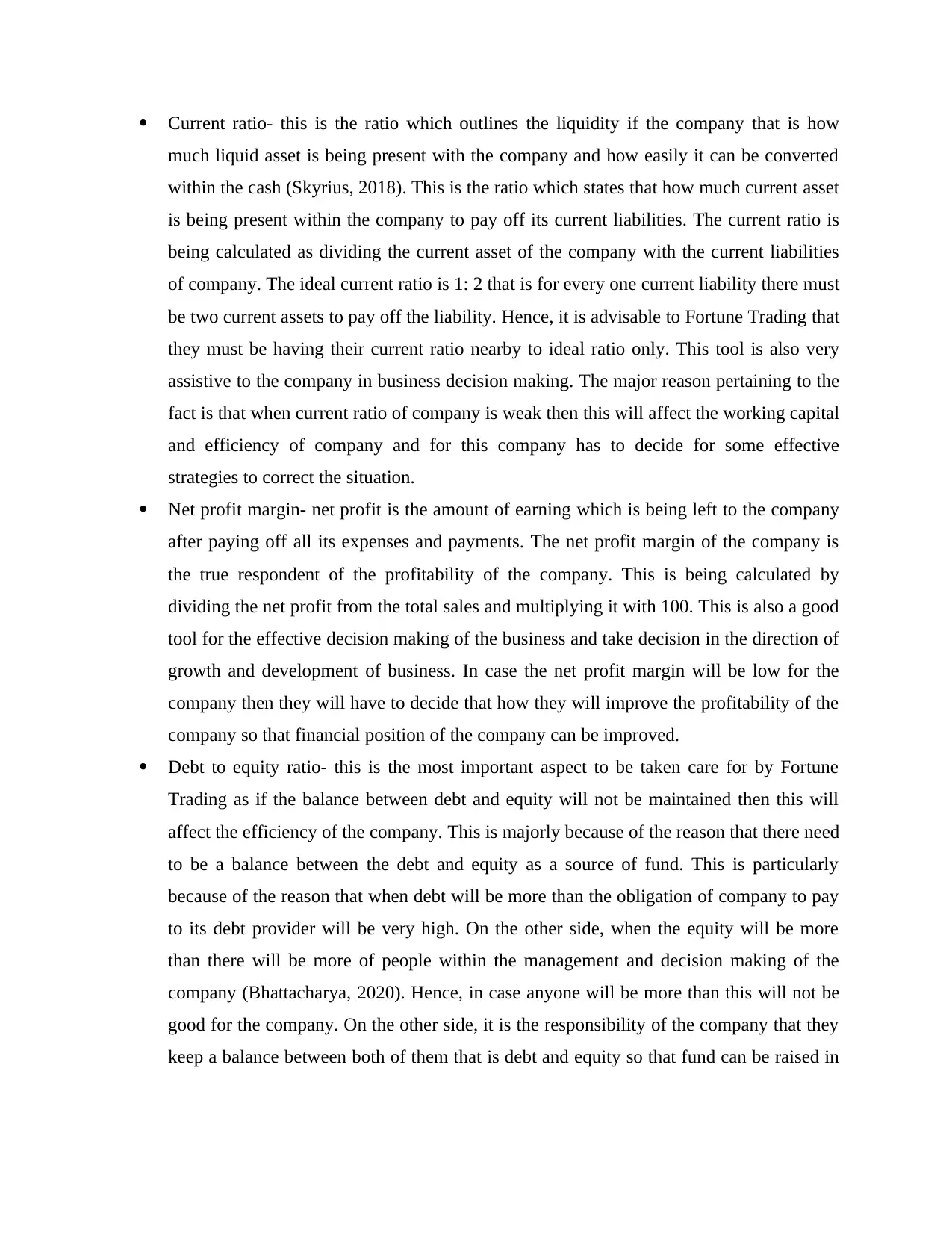
Current ratio- this is the ratio which outlines the liquidity if the company that is how
much liquid asset is being present with the company and how easily it can be converted
within the cash (Skyrius, 2018). This is the ratio which states that how much current asset
is being present within the company to pay off its current liabilities. The current ratio is
being calculated as dividing the current asset of the company with the current liabilities
of company. The ideal current ratio is 1: 2 that is for every one current liability there must
be two current assets to pay off the liability. Hence, it is advisable to Fortune Trading that
they must be having their current ratio nearby to ideal ratio only. This tool is also very
assistive to the company in business decision making. The major reason pertaining to the
fact is that when current ratio of company is weak then this will affect the working capital
and efficiency of company and for this company has to decide for some effective
strategies to correct the situation.
Net profit margin- net profit is the amount of earning which is being left to the company
after paying off all its expenses and payments. The net profit margin of the company is
the true respondent of the profitability of the company. This is being calculated by
dividing the net profit from the total sales and multiplying it with 100. This is also a good
tool for the effective decision making of the business and take decision in the direction of
growth and development of business. In case the net profit margin will be low for the
company then they will have to decide that how they will improve the profitability of the
company so that financial position of the company can be improved.
Debt to equity ratio- this is the most important aspect to be taken care for by Fortune
Trading as if the balance between debt and equity will not be maintained then this will
affect the efficiency of the company. This is majorly because of the reason that there need
to be a balance between the debt and equity as a source of fund. This is particularly
because of the reason that when debt will be more than the obligation of company to pay
to its debt provider will be very high. On the other side, when the equity will be more
than there will be more of people within the management and decision making of the
company (Bhattacharya, 2020). Hence, in case anyone will be more than this will not be
good for the company. On the other side, it is the responsibility of the company that they
keep a balance between both of them that is debt and equity so that fund can be raised in
much liquid asset is being present with the company and how easily it can be converted
within the cash (Skyrius, 2018). This is the ratio which states that how much current asset
is being present within the company to pay off its current liabilities. The current ratio is
being calculated as dividing the current asset of the company with the current liabilities
of company. The ideal current ratio is 1: 2 that is for every one current liability there must
be two current assets to pay off the liability. Hence, it is advisable to Fortune Trading that
they must be having their current ratio nearby to ideal ratio only. This tool is also very
assistive to the company in business decision making. The major reason pertaining to the
fact is that when current ratio of company is weak then this will affect the working capital
and efficiency of company and for this company has to decide for some effective
strategies to correct the situation.
Net profit margin- net profit is the amount of earning which is being left to the company
after paying off all its expenses and payments. The net profit margin of the company is
the true respondent of the profitability of the company. This is being calculated by
dividing the net profit from the total sales and multiplying it with 100. This is also a good
tool for the effective decision making of the business and take decision in the direction of
growth and development of business. In case the net profit margin will be low for the
company then they will have to decide that how they will improve the profitability of the
company so that financial position of the company can be improved.
Debt to equity ratio- this is the most important aspect to be taken care for by Fortune
Trading as if the balance between debt and equity will not be maintained then this will
affect the efficiency of the company. This is majorly because of the reason that there need
to be a balance between the debt and equity as a source of fund. This is particularly
because of the reason that when debt will be more than the obligation of company to pay
to its debt provider will be very high. On the other side, when the equity will be more
than there will be more of people within the management and decision making of the
company (Bhattacharya, 2020). Hence, in case anyone will be more than this will not be
good for the company. On the other side, it is the responsibility of the company that they
keep a balance between both of them that is debt and equity so that fund can be raised in
⊘ This is a preview!⊘
Do you want full access?
Subscribe today to unlock all pages.

Trusted by 1+ million students worldwide
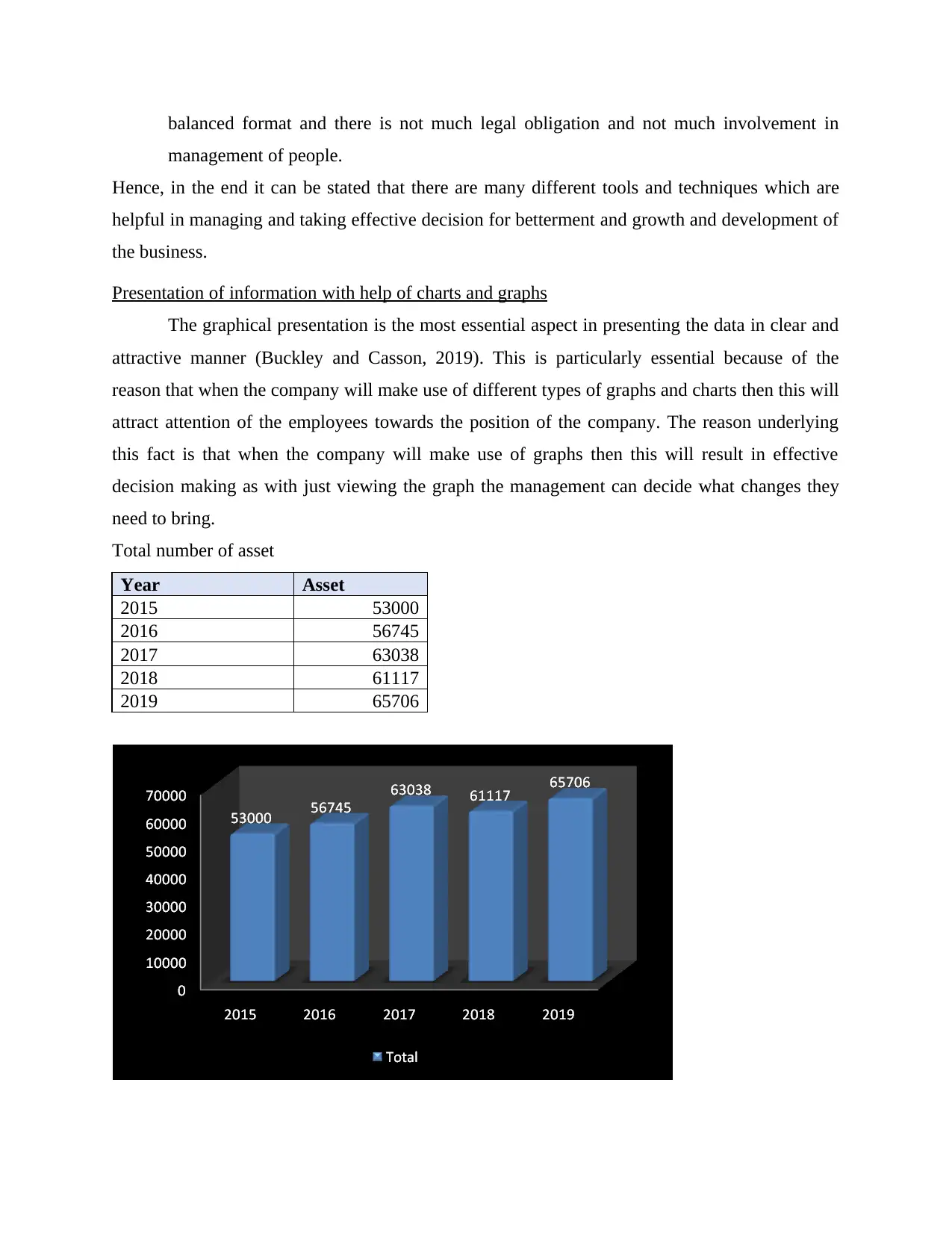
balanced format and there is not much legal obligation and not much involvement in
management of people.
Hence, in the end it can be stated that there are many different tools and techniques which are
helpful in managing and taking effective decision for betterment and growth and development of
the business.
Presentation of information with help of charts and graphs
The graphical presentation is the most essential aspect in presenting the data in clear and
attractive manner (Buckley and Casson, 2019). This is particularly essential because of the
reason that when the company will make use of different types of graphs and charts then this will
attract attention of the employees towards the position of the company. The reason underlying
this fact is that when the company will make use of graphs then this will result in effective
decision making as with just viewing the graph the management can decide what changes they
need to bring.
Total number of asset
Year Asset
2015 53000
2016 56745
2017 63038
2018 61117
2019 65706
management of people.
Hence, in the end it can be stated that there are many different tools and techniques which are
helpful in managing and taking effective decision for betterment and growth and development of
the business.
Presentation of information with help of charts and graphs
The graphical presentation is the most essential aspect in presenting the data in clear and
attractive manner (Buckley and Casson, 2019). This is particularly essential because of the
reason that when the company will make use of different types of graphs and charts then this will
attract attention of the employees towards the position of the company. The reason underlying
this fact is that when the company will make use of graphs then this will result in effective
decision making as with just viewing the graph the management can decide what changes they
need to bring.
Total number of asset
Year Asset
2015 53000
2016 56745
2017 63038
2018 61117
2019 65706
Paraphrase This Document
Need a fresh take? Get an instant paraphrase of this document with our AI Paraphraser
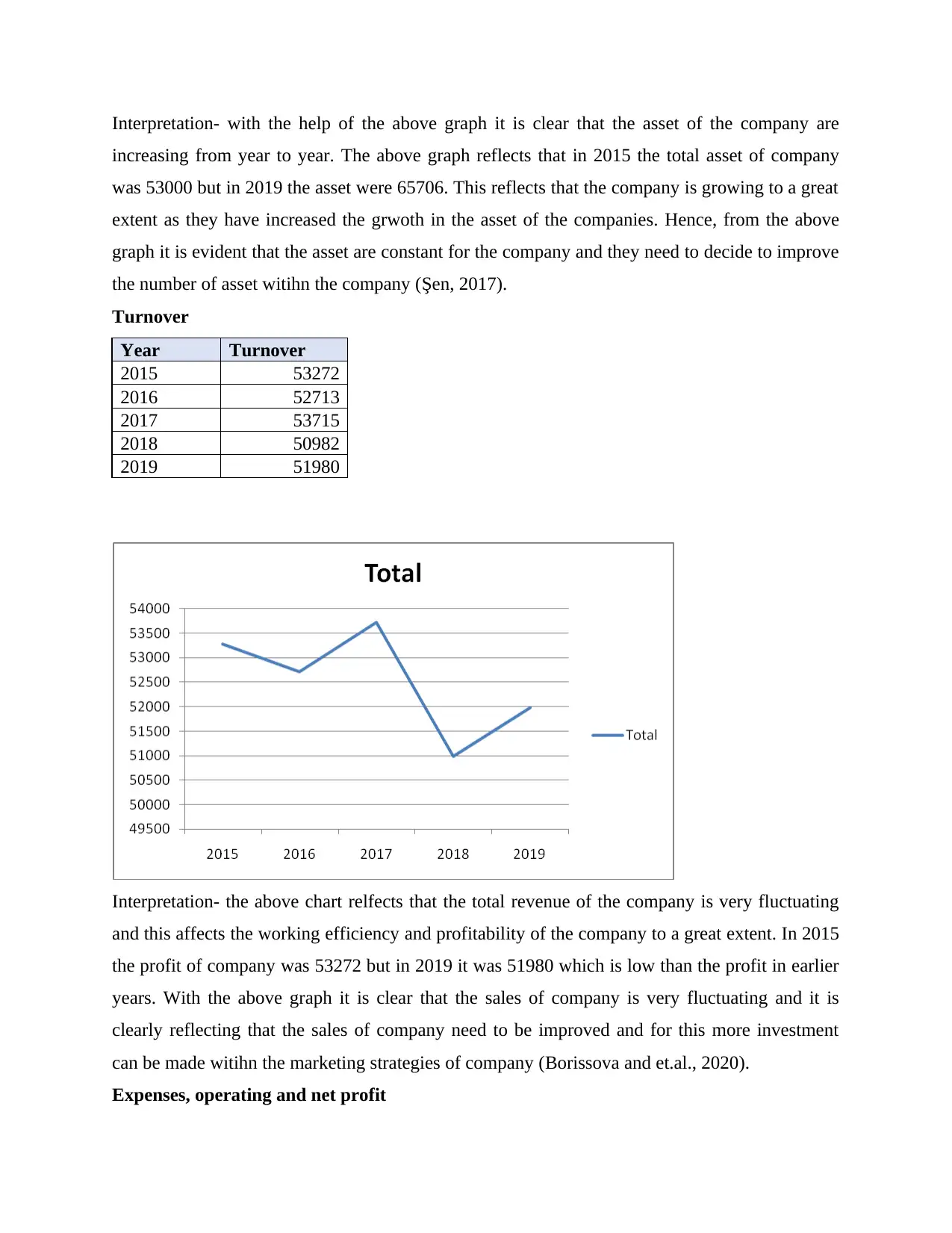
Interpretation- with the help of the above graph it is clear that the asset of the company are
increasing from year to year. The above graph reflects that in 2015 the total asset of company
was 53000 but in 2019 the asset were 65706. This reflects that the company is growing to a great
extent as they have increased the grwoth in the asset of the companies. Hence, from the above
graph it is evident that the asset are constant for the company and they need to decide to improve
the number of asset witihn the company (Şen, 2017).
Turnover
Year Turnover
2015 53272
2016 52713
2017 53715
2018 50982
2019 51980
Interpretation- the above chart relfects that the total revenue of the company is very fluctuating
and this affects the working efficiency and profitability of the company to a great extent. In 2015
the profit of company was 53272 but in 2019 it was 51980 which is low than the profit in earlier
years. With the above graph it is clear that the sales of company is very fluctuating and it is
clearly reflecting that the sales of company need to be improved and for this more investment
can be made witihn the marketing strategies of company (Borissova and et.al., 2020).
Expenses, operating and net profit
increasing from year to year. The above graph reflects that in 2015 the total asset of company
was 53000 but in 2019 the asset were 65706. This reflects that the company is growing to a great
extent as they have increased the grwoth in the asset of the companies. Hence, from the above
graph it is evident that the asset are constant for the company and they need to decide to improve
the number of asset witihn the company (Şen, 2017).
Turnover
Year Turnover
2015 53272
2016 52713
2017 53715
2018 50982
2019 51980
Interpretation- the above chart relfects that the total revenue of the company is very fluctuating
and this affects the working efficiency and profitability of the company to a great extent. In 2015
the profit of company was 53272 but in 2019 it was 51980 which is low than the profit in earlier
years. With the above graph it is clear that the sales of company is very fluctuating and it is
clearly reflecting that the sales of company need to be improved and for this more investment
can be made witihn the marketing strategies of company (Borissova and et.al., 2020).
Expenses, operating and net profit
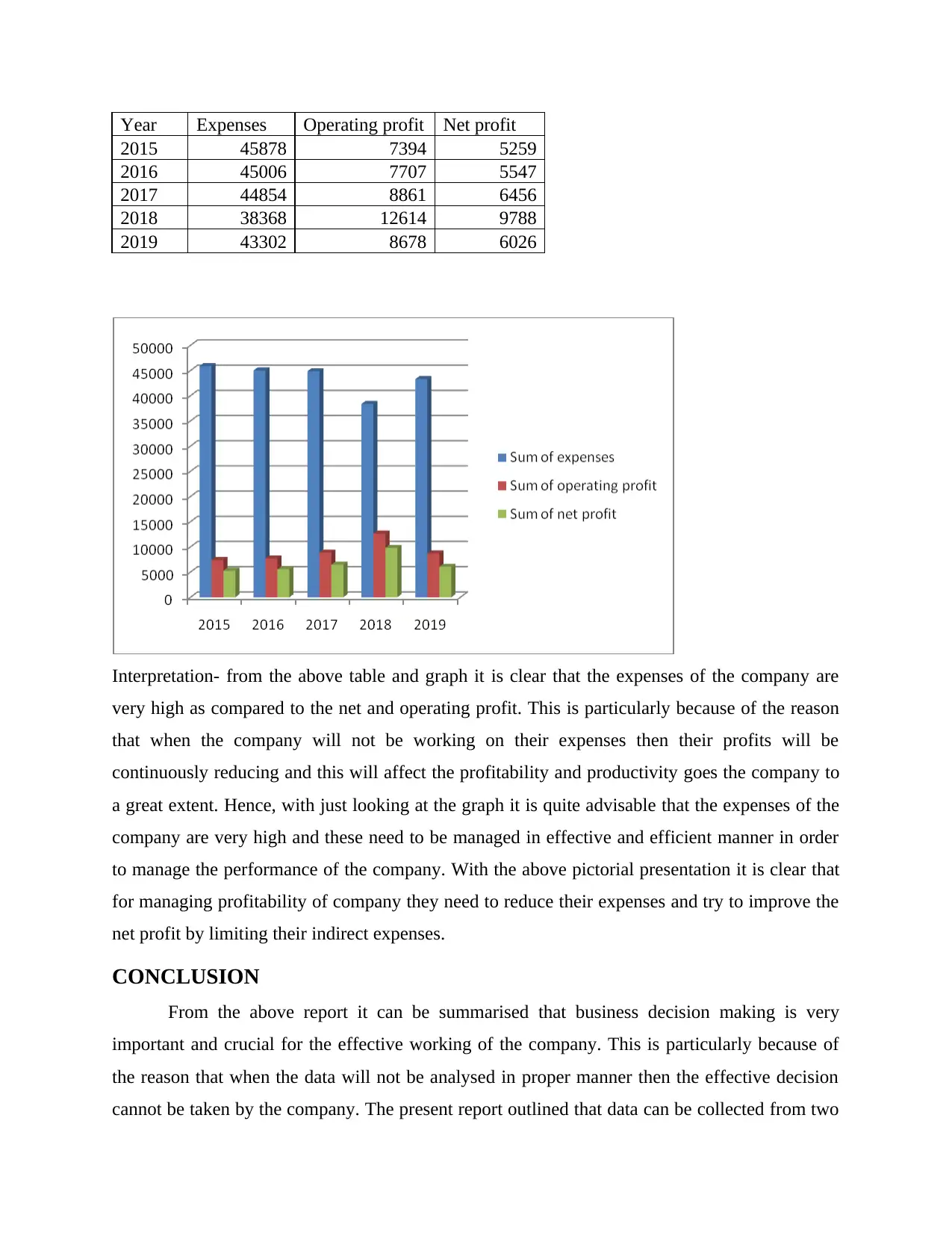
Year Expenses Operating profit Net profit
2015 45878 7394 5259
2016 45006 7707 5547
2017 44854 8861 6456
2018 38368 12614 9788
2019 43302 8678 6026
Interpretation- from the above table and graph it is clear that the expenses of the company are
very high as compared to the net and operating profit. This is particularly because of the reason
that when the company will not be working on their expenses then their profits will be
continuously reducing and this will affect the profitability and productivity goes the company to
a great extent. Hence, with just looking at the graph it is quite advisable that the expenses of the
company are very high and these need to be managed in effective and efficient manner in order
to manage the performance of the company. With the above pictorial presentation it is clear that
for managing profitability of company they need to reduce their expenses and try to improve the
net profit by limiting their indirect expenses.
CONCLUSION
From the above report it can be summarised that business decision making is very
important and crucial for the effective working of the company. This is particularly because of
the reason that when the data will not be analysed in proper manner then the effective decision
cannot be taken by the company. The present report outlined that data can be collected from two
2015 45878 7394 5259
2016 45006 7707 5547
2017 44854 8861 6456
2018 38368 12614 9788
2019 43302 8678 6026
Interpretation- from the above table and graph it is clear that the expenses of the company are
very high as compared to the net and operating profit. This is particularly because of the reason
that when the company will not be working on their expenses then their profits will be
continuously reducing and this will affect the profitability and productivity goes the company to
a great extent. Hence, with just looking at the graph it is quite advisable that the expenses of the
company are very high and these need to be managed in effective and efficient manner in order
to manage the performance of the company. With the above pictorial presentation it is clear that
for managing profitability of company they need to reduce their expenses and try to improve the
net profit by limiting their indirect expenses.
CONCLUSION
From the above report it can be summarised that business decision making is very
important and crucial for the effective working of the company. This is particularly because of
the reason that when the data will not be analysed in proper manner then the effective decision
cannot be taken by the company. The present report outlined that data can be collected from two
⊘ This is a preview!⊘
Do you want full access?
Subscribe today to unlock all pages.

Trusted by 1+ million students worldwide
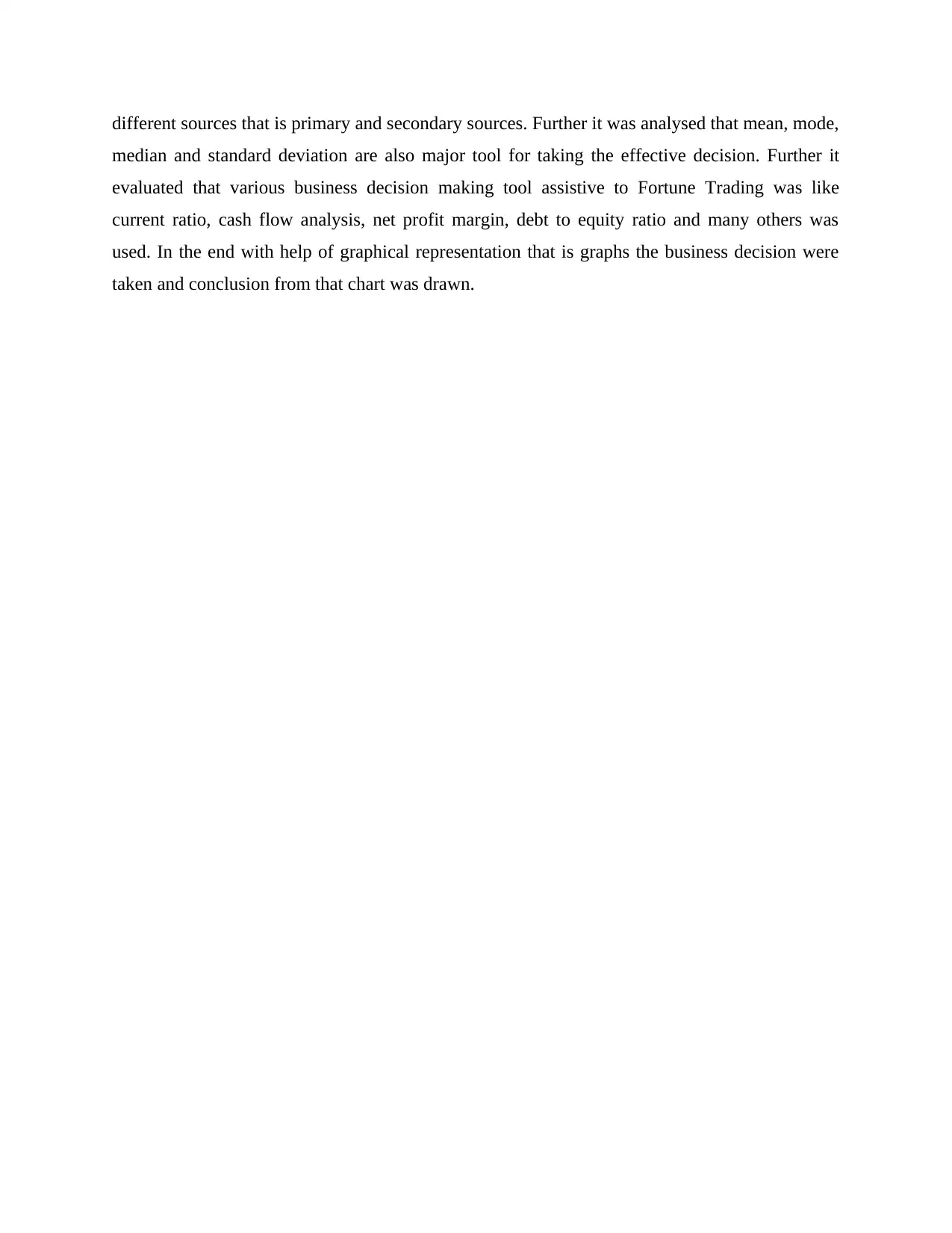
different sources that is primary and secondary sources. Further it was analysed that mean, mode,
median and standard deviation are also major tool for taking the effective decision. Further it
evaluated that various business decision making tool assistive to Fortune Trading was like
current ratio, cash flow analysis, net profit margin, debt to equity ratio and many others was
used. In the end with help of graphical representation that is graphs the business decision were
taken and conclusion from that chart was drawn.
median and standard deviation are also major tool for taking the effective decision. Further it
evaluated that various business decision making tool assistive to Fortune Trading was like
current ratio, cash flow analysis, net profit margin, debt to equity ratio and many others was
used. In the end with help of graphical representation that is graphs the business decision were
taken and conclusion from that chart was drawn.
Paraphrase This Document
Need a fresh take? Get an instant paraphrase of this document with our AI Paraphraser
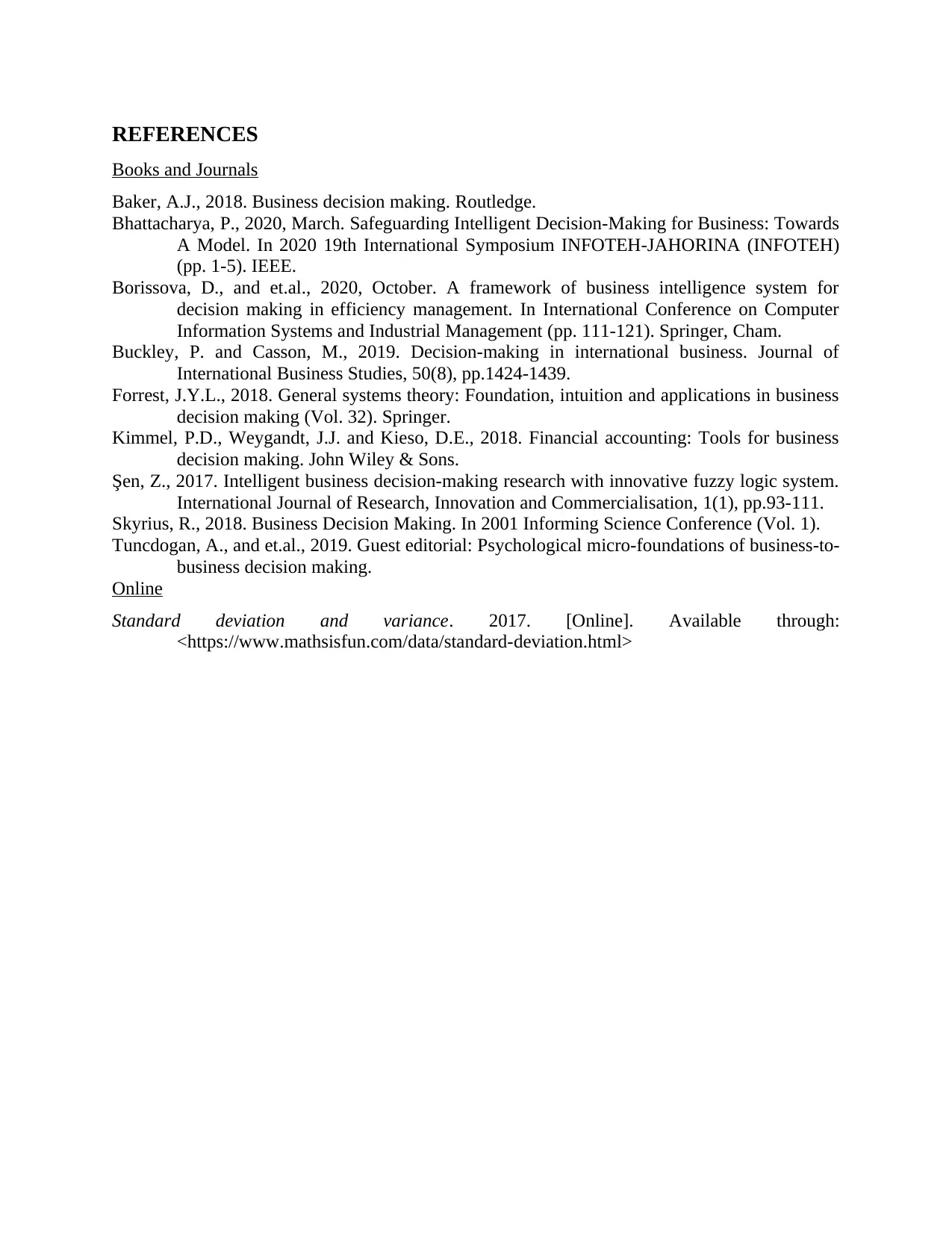
REFERENCES
Books and Journals
Baker, A.J., 2018. Business decision making. Routledge.
Bhattacharya, P., 2020, March. Safeguarding Intelligent Decision-Making for Business: Towards
A Model. In 2020 19th International Symposium INFOTEH-JAHORINA (INFOTEH)
(pp. 1-5). IEEE.
Borissova, D., and et.al., 2020, October. A framework of business intelligence system for
decision making in efficiency management. In International Conference on Computer
Information Systems and Industrial Management (pp. 111-121). Springer, Cham.
Buckley, P. and Casson, M., 2019. Decision-making in international business. Journal of
International Business Studies, 50(8), pp.1424-1439.
Forrest, J.Y.L., 2018. General systems theory: Foundation, intuition and applications in business
decision making (Vol. 32). Springer.
Kimmel, P.D., Weygandt, J.J. and Kieso, D.E., 2018. Financial accounting: Tools for business
decision making. John Wiley & Sons.
Şen, Z., 2017. Intelligent business decision-making research with innovative fuzzy logic system.
International Journal of Research, Innovation and Commercialisation, 1(1), pp.93-111.
Skyrius, R., 2018. Business Decision Making. In 2001 Informing Science Conference (Vol. 1).
Tuncdogan, A., and et.al., 2019. Guest editorial: Psychological micro-foundations of business-to-
business decision making.
Online
Standard deviation and variance. 2017. [Online]. Available through:
<https://www.mathsisfun.com/data/standard-deviation.html>
Books and Journals
Baker, A.J., 2018. Business decision making. Routledge.
Bhattacharya, P., 2020, March. Safeguarding Intelligent Decision-Making for Business: Towards
A Model. In 2020 19th International Symposium INFOTEH-JAHORINA (INFOTEH)
(pp. 1-5). IEEE.
Borissova, D., and et.al., 2020, October. A framework of business intelligence system for
decision making in efficiency management. In International Conference on Computer
Information Systems and Industrial Management (pp. 111-121). Springer, Cham.
Buckley, P. and Casson, M., 2019. Decision-making in international business. Journal of
International Business Studies, 50(8), pp.1424-1439.
Forrest, J.Y.L., 2018. General systems theory: Foundation, intuition and applications in business
decision making (Vol. 32). Springer.
Kimmel, P.D., Weygandt, J.J. and Kieso, D.E., 2018. Financial accounting: Tools for business
decision making. John Wiley & Sons.
Şen, Z., 2017. Intelligent business decision-making research with innovative fuzzy logic system.
International Journal of Research, Innovation and Commercialisation, 1(1), pp.93-111.
Skyrius, R., 2018. Business Decision Making. In 2001 Informing Science Conference (Vol. 1).
Tuncdogan, A., and et.al., 2019. Guest editorial: Psychological micro-foundations of business-to-
business decision making.
Online
Standard deviation and variance. 2017. [Online]. Available through:
<https://www.mathsisfun.com/data/standard-deviation.html>
1 out of 11
Related Documents
Your All-in-One AI-Powered Toolkit for Academic Success.
+13062052269
info@desklib.com
Available 24*7 on WhatsApp / Email
![[object Object]](/_next/static/media/star-bottom.7253800d.svg)
Unlock your academic potential
Copyright © 2020–2025 A2Z Services. All Rights Reserved. Developed and managed by ZUCOL.





